#RIP Rachel Pollack
Text
(This is a really incredible essay by the recently-passed author and trans legend Rachel Pollack, first published in issue #9 of TransSisters: The Journal of Transsexual Feminism. I wanted to reproduce it here in full because it's a goddamn banger, because archived PDFs can be a bit hard to read, and because every trans person should get the opportunity to read it at least once.)
***

Archetypal Transsexuality
By Rachel Pollack, 1995
The San Rafael Hospital in Trinidad, Colorado has become a kind of shrine for transsexual people in America. Even for those who did not get surgery from Dr. Stanley Biber, his clinic in San Rafael has become synonymous with "sex reassignment surgery" in the same way that the entire nation of Denmark came to symbolize "sex changes" in the 1950s and 1960s, after Christine Jorgensen stepped out of Copenhagen and into the world.
A small hill rises behind the hospital, and on top of it, surrounded by trees and flowers stands a genuine shrine, a small structure dedicated to the Virgin Mary. Behind a conventional statue of Mary, with room for candies and other offerings, the building houses a more precious sculpture of the Christian Goddess. According to the plaque at the front of the shrine, a Trinidad man was caught in a blizzard and in danger of being blown away when be came upon the statue of Mary and clung to it until the fury of nature broke open and he could find his way to help and recovery. The sanctuary he created looks over Dr. Biber's clinic, gently blessing all the trans-formed women and men who pass through its doors.
Now, Mary occupies an interesting place in the history of mythology. Many people know that while the Christian Church attempted to portray God as entirely male, the ordinary people clung to Mother Mary as giver of hope, mercy, and nurturance. Less known is fact that the early Church consciously adapted aspects of various Pagan Goddesses to create Mary's image and place her in the hearts of the people. Two Goddesses in particular contributed to Mary: Aphrodite, who rose from the sea, and Cybele, a Goddess from Asia Minor who earlier had made a triumphant entry into Rome as the Great Mother of the Gods.
I have written elsewhere of Aphrodite as a transsexual Goddess. Her story tells us how the Sky God, Ouranos, was oppressing Gaia, the Earth, until Gaia gave a sickle (a women's harvest tool shaped like the crescent Moon) to her son Kronos. Kronos cut off his father's genitals and threw them into the sea. Ouranos does not die in the story, but withdraws into the shadows, the same way the male persona of many transsexual women will withdraw once the female reality has given itself permission to emerge. The severed genitals, however, do not sink out of sight. Instead. they stir up a great foam on the waters. Out of this foam, golden Aphrodite. the embodiment of femininity in all its grace and power, emerges into the world.
And Cybele -- when the Great Mother came to Rome she brought with her her Gallae. The Gallae were anatomical males who, in the midst of ecstatic group frenzy, used stone sickles to sever their own genitals, which they then flung through open doorways. The families who received the bloody relics considered them a blessing. In return for Cybele's grace, a family would tend to the bleeding Galla and nurse her back to health, at which time she ceremoniously received women's clothing and entered into the service of her Goddess.
The presence of Mary overlooking the San Rafael clinic, and in particular her mysterious emergence out of a storm, forms part of a great web of images and history. The web includes all the mythological figures who change sex or cross genders. It includes the real life Gallae and Hijras and others who alter their bodies as well as the tribal shamans who move into the roles of the "opposite" sex, usually not as a matter of conscious choice, but because the spirits demand it of them. It includes the Stone Age evidence of androgynous Goddesses and cross- sexed priests and priestesses alongside the increasing numbers of contemporary transsexuals who have begun to understand that, as Davina Anne Gabriel puts it, we cannot comprehend transsexuality without some notion of "transcendence," or, as Dallas Denny says, more bluntly, "Transsexuality is a religious experience."
To recognize our place in that web means, paradoxically, to step out of a trap. This is the trap in which we experience transsexuality as a sickness, or even just a psychological condition. For transsexual people, such an ideology (and that is what it is) has become more and more of a dead end - literally, with so many people losing their lives to depression, suicide, bad drugs, unsafe sex and all the other miseries that allow the purveyors of pathology to say "There? You see? If it wasn't a sickness, wouldn't they all be happy?"
Even those of us who insist that transsexual people are not "sick" will still talk about "healing," whether we think we need to heal from shame, or society's oppression, or unhappy childhoods. But as long as we speak of healing we stay within the world of sickness. In the United States we consider happiness the basic human condition, and any suffering as some sort of aberration. I would argue that transsexuality arises from a passion so powerful that it transcends issues of happiness. The word passion originally meant suffering, not pleasure. The suffering of transsexuality, however, is like that of religious ecstasy, or even orgasm -- overwhelming, intense, and ultimately joyous when we surrender to it and let it carry us into the power of the experience.
Think where transsexual desire leads us. We give up our positions in society (I am not talking here about the slide downwards in status for male-to-females, but much more basically of our very places in the world, a loss that applies to transsexual men as well as to women, even if the men eventually go up in status). We risk losing our family and friends. We face ridicule and sometimes extreme violence, even death. We take powerful and dangerous drugs to alter the very shape of our bodies. And finally, we undergo -- we seek out, even demand -- surgery on our genitals. No logical decision, or confusion, or social conditioning, or even mental illness, can account for such an overwhelming need.
Recently, a number of transsexual and transgender people have suggested that people seek surgery because of pressure from the medical profession, which convinces them that surgery will allow them to become normal members of society. I cannot believe this. I have met too many transsexuals who know very clearly that surgery is exactly and precisely what they want, and that the doctors are not their masters but their instruments.
To describe transsexual people as dupes of the medical profession, or slaves to social conditioning, or trapped in rigid ideas about gender roles, is precisely to take away our power, a power so intense that it terrifies people. Sometimes we can see the question in their faces. "What would make someone do -- or want to do -- such a thing?" And because the dual acts of changing gender and altering the body frighten them they try to think of an explanation. "He must hate himself so much." "She can't accept the role society has given her." "Her parents must have abused her." Each of these statements, and all the others, assume that the transsexual man or woman doesn't really know what he or she is doing. And more, they shift the focus from transsexuality itself to some external concept or ideology. All explanations, even friendly ones, drain away the passion of the experience.
It is time to realize that changing gender and altering the body are not the same thing. While many people cannot imagine a gender change without surgery, many others find surgery totally unnecessary. And many people who have surgery will say clearly that it is not the surgeon's knife that makes them men or women, that surgery only changes the outer form to match their inner feelings. The confusion of surgery with gender identity leads many people to think of postoperative transsexual people as superior to preops or to people who change gender without caring about surgery at all. This hierarchy is unfortunate , because it sets people against each other when them is no need for that. At the same time, it also takes away the mystery of surgery itself. Once again, it "explains" surgery as a way just to prove something, or to join an elite. But genital surgery is too strong an experience to dismiss in this way.
Gender identity is a matter of self-knowledge, but also of social functioning. We inhabit our gender and exhibit it to the world. Genital surgery is not really a social experience at all. Obviously, it becomes important in intimate sexual relationships. It may also give us more confidence, as well as legal status. Ultimately, however, surgery is private. It forms a mystery of the body. It may have more in common with religious body altering, such as ritual scarring, than with changing gender. (It is important to remember, however, that transsexual people not only desire surgery but go to great lengths to get it. This makes the experience radically different from any body altering imposed unwillingly on people, such as clitoridectomy performed on pre-adolescent girls, or even the surgery done on intersex babies.)
There is a verse in the Tao Te Ching, the ancient Chinese teaching on "the Way", that speaks directly to some of these issues. In the translation of Gia-fu Feng by Jane English it reads as follows:
"Knowing ignorance is strength.
Ignoring knowledge is sickness.
If one is sick of sickness, then one is not sick.
The sage is not sick because he is sick of sickness.
Therefore he is not sick."
Whenever we try to find the cause of our transsexuality we become weak. This is because we deny its reality within our selves and try to find some explanation outside of us. Some sickness or conditioning. If we know and accept that we are ignorant of what makes us transsexual, and that we should not waste our energy trying to pinpoint some external cause, then "knowing ignorance" will indeed become a source of strength.
But if we cannot know what causes transsexuality, we can know a great deal about it. We can acknowledge its power and its reality, we can learn about other transsexual people and their experiences, and we can discover its ancient worldwide history. To ignore all this knowledge only weakens us and makes us sick.
To overcome the pathology that our culture attaches to transsexuality, we need, above all, to want to overcome it. To finally and utterly reject it. To be sick of sickness. At the moment that we do this, that we become sick of sickness, we begin to escape it, and the deeper we go in that direction, the greater our liberation.
Carl Jung once remarked that the ancients had gods, we have complexes. The Gallae may have experienced feelings and desires similar to those of modem transsexual women. After all, since no one chose them to be Gallae, they must have felt the same overwhelming push to present themselves. But instead of seeing themselves as compelled by a sickness, they believed their Goddess had called them into Her service. Both viewpoints require a surrender, but when we surrender to a Goddess we join ourselves to her power and her beauty. When we surrender to a sickness we get nothing but shame.
Here are two more aspects of that web of images. In Greece, the main God who ruled over transgendered activities was Dionysus. His male followers would dress as women, his female followers would strap on large phalluses. He himself was depicted as a stick with a dress and a beard. Some of the more patriarchal Greek writers described him as "effeminate" or "womanly." Indeed, his myth tells us that he was raised as a girl, and even when he came into his Godhood he often wore feminine clothes and kept his hair long and flowing, something only women were supposed to do.
The psychologist Ginette Paris tells us an interesting story about Dionysus. Raised as a girl, he went mad in adolescence. Paris tells us that we do not know the cause of his madness. Certainly some of the readers of this magazine might make a guess. Insane, Dionysus wanders the world until he comes to Phrygia. the home not only of Cybele and the Gallae, but according to some accounts, Aphrodite. Cybele initiates him, Paris tells us, and restores his sanity. Paris says we do not know how Cybele heals him. Did she initiate him back into his femaleness? Did she lead the God to embrace the doubleness of gender? After he returned from his wanderings, Dionysus became the God of ecstasy, leading men but especially women out of the traps laid for them by a rigid polarized society.
The second myth does not invoke transgendered or transsexual issues quite so directly. However, it involves someone clinging to a statue for deliverance from an emotional storm, and thus it returns us to the presence of Mary overlooking and blessing Dr. Biber's clinic. The Greek Orestes went mad -- madness again -- after Apollo ordered him to kill his mother as punishment for her crime of murdering her husband. Though the Goddess Athena absolved him he still had to pay a penance to the Goddess Artemis (Orestes' mother had killed her husband because he had sacrificed their daughter to Artemis in the hope of gaining the Goddess's favor -- the story of Orestes involves generations of murder and abuse). Thus Orestes wandered the world carrying a statue of Artemis. Finally, he felt the insanity leave him, and he dared to put it down. He set it in a riverbed and walked away. Two Spartans passed by. When they saw the statue staring at them, horribly, from the water, they went mad.
Now, Spartans were known for being ultra-masculine, while Orestes, despite his defense of his father, was considered -- like Dionysus -- effeminate. Thus, the rigidly male Spartans cannot believe the sudden emergence of the dark feminine. But there are more direct connections to our own stories. Artemis was often linked with Cybele. The most famous statue of Artemis stood not in Greece but in Ephesus, a town in Asia Minor, the home territory of Cybele. The Phrygians themselves described Artemis as another name for Cybele.
The Ephesus statue showed the Goddess's torso covered in small globes. Most modern writers assume these are extra breasts, showing her power as the Great Mother. Recently, however, a British archaeologist pointed out that the globes have no nipples. The archaeologist suggested they might have represented the testicles sacrificed by Artemis/Cybele's gallae worshippers.
Classical Greek Artemis was not a mother Goddess but a virgin. We might describe her as forming a link between transsexual women and lesbians (or between the two sides of a transsexual lesbian). Goddess of the Moon, Artemis lived in the mountains apart from the male dominated civilization. She refused all contact with men, spending her time with her band of nymphs. A lover, as well as hunter, of animals, she also watched over women in childbirth. In short, she is almost the model of a back to the land radical lesbian. And yet, as Cybele. she also is the Goddess who accepts the Gallae into her service.
And a final link -- the early Christian council which established Mary as officially the Mother of God took place in Ephesus, the site of that famous statue, once considered one of the seven wonders of the world. And so we come full circle, to Mary, and to Cybele/Artemis, and to statues.
Writing about the story of Orestes, the statue of Artemis, and the two Spartans, Roberto Calasso states: "Such is the power of the image; it heals only those who know what it is. For all others, it is an illness." Transsexuality comes to us with all the power of a divine force who will not be denied. If we recognize it and accept it as a true vision of the self from the deepest part of the psyche, if we carry the Goddess with us until we find ourselves strong enough to set her down, then we may find it opens us to a life of spirituality and joy. If we try to deny it, or belittle it, or explain it away, it can destroy us. Knowing ignorance is strength. Ignoring knowledge is sickness.
If one is sick of sickness, then one is not sick.
***
#WHENEVER WE TRY TO FIND THE CAUSE OF OUR TRANSSEXUALITY WE BECOME WEAK#IF ONE IS SICK OF SICKNESS THEN ONE IS NOT SICK#I'm normally pretty allergic to invocations of spirituality#but this is a perfectly-notched arrow that goes straight through my heart#RIP Rachel Pollack#1945-2023
8 notes
·
View notes
Photo
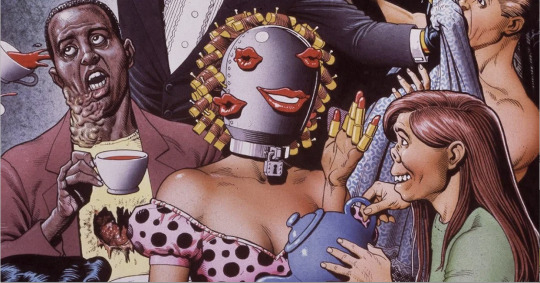
Doom Patrol Book Four (cover detail)
by Brian Bolland
RIP Rachel Pollack
2 notes
·
View notes
Photo

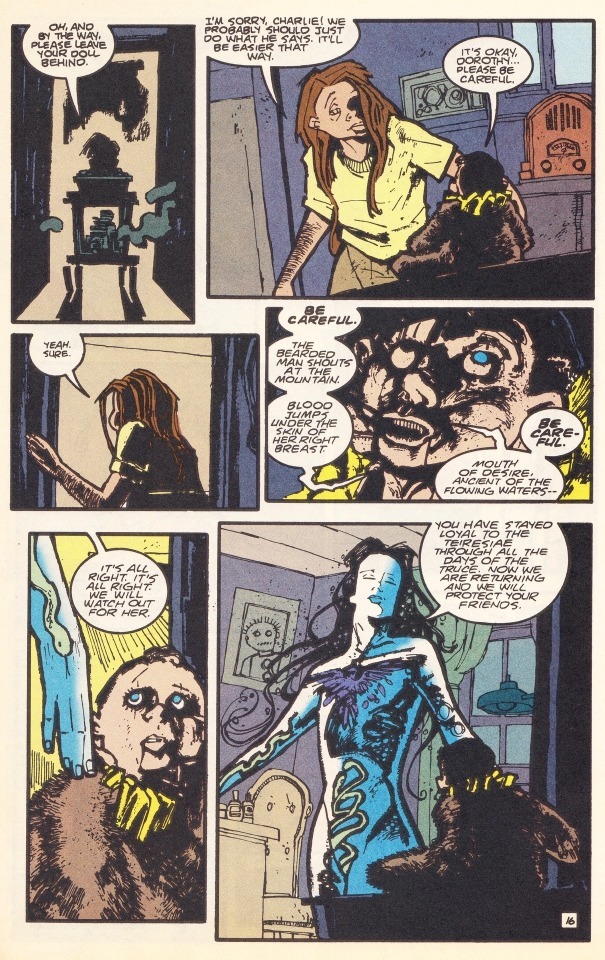
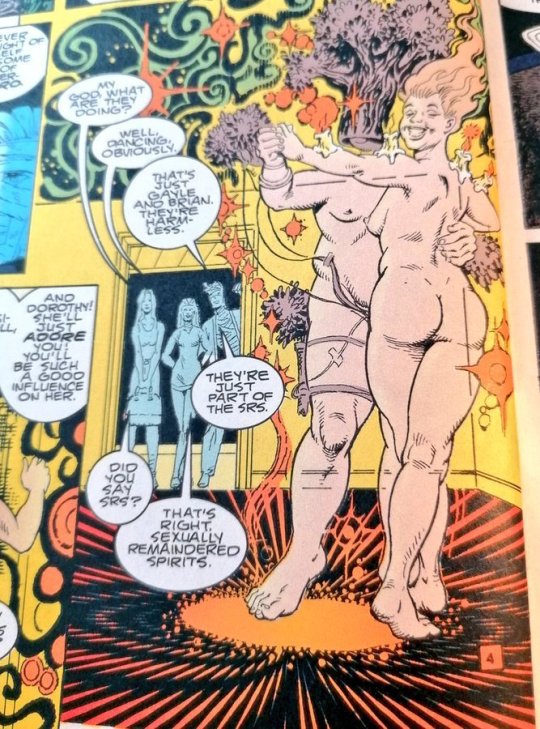

RIP Rachel Pollack, but then not. Sorry, I was wrong. Thank you, @ripplepipple!
70 notes
·
View notes
Text
Even knowing it was coming, losing Rachel Pollack hits hard, RIP to an icon
2 notes
·
View notes
Text
rip rachel pollack💔 thank you for everything
0 notes
Text
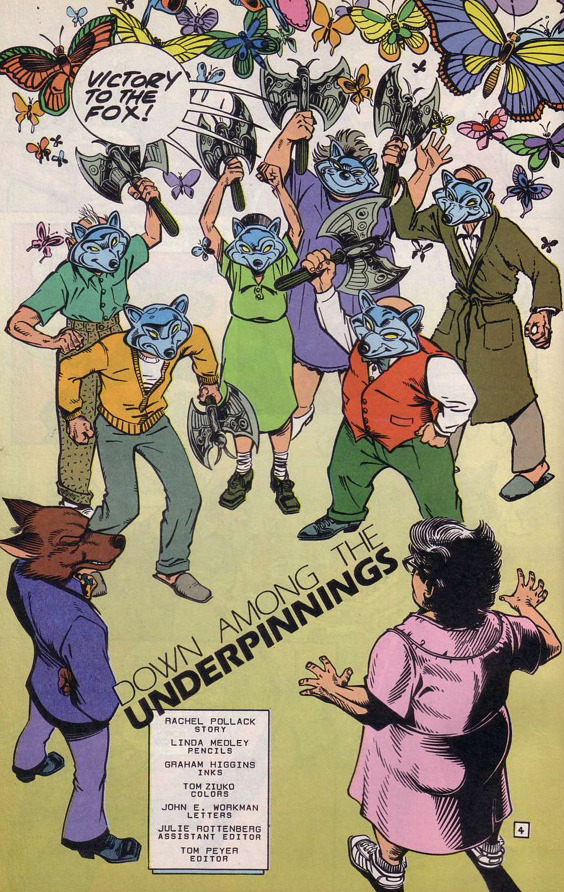
RIP Rachel Pollack
(I was going to go with a picture of Codpiece but he seems to already be her most enduring creation, so here's a bit I always recall when I think of her Doom Patrol run, even though it's well after the point where I had any clue at all what was happening in it)
0 notes
Photo

Doom Patrol by Rachel Pollack (1993)
[ID: Cliff Steele, lying on a green bedspread and being straddled by Kate Goodwin, who is doing his make up. Cliff’s wearing his signature leather jacket and a grey top with a rip in one side. His nails are painted dark purple and he’s wearing black lipstick, along with red eyeshadow. There’s a trans pride sticker on his head. Kate is standing over him with a make-up brush in one hand and a set of palettes in the other. She wears a short pink skirt and a dark blue tank top. Her nails are painted a slightly darker pink.]
#doom patrol#kate godwin#cliff steele#cliffkate#alt title for this:#doom patrol teiresias wars#odad#realized i could draw a background but then you guys might start expecting things of me artwise and i cant have that#also ty to alexis for finding me the image this was inspired by
74 notes
·
View notes
Text
#1yrago Happy Public Domain day: for real, for the first time in 20 years!

Every year, Jennifer Jenkins and Jamie Boyle from the Duke Center for the Public Domain compile a "Public Domain Day" list (previously) that highlights the works that are not entering the public domain in America, thanks to the 1998 Sonny Bono Copyright Term Extension Act, which hit the pause button on Americans' ability to freely use their artistic treasures for two decades -- a list that also included the notable works entering the public domain in more sensible countries of the Anglophere, like Canada and the UK, where copyright "only" lasted for 50 years after the author's death.
But this year, it's different.
This is the year that America unpauses its public domain; it's also the year that Canadian PM Justin Trudeau capitulated to Donald Trump and retroactively extended copyright on works in Canada for an extra 20 years, ripping works out of Canada's public domain, making new works based on them into illegal art (more proof that good hair and good pecs don't qualify you to be a good leader -- see also: V. Putin -- not even when paired with high-flying, cheap rhetoric).
Even as Canada's public domain has radically contracted, America's has, for the first, time, opened.
So this year's American Public Domain Day List is, for the first time in 20 years, not a work melancholy alternate history, but rather a celebration of works that Americans are newly given access to without restriction or payment, for free re-use and adaptation, in the spirit of such classics as Snow White, West Side Story, My Fair Lady, All You Need is Love, and more (More than 1,000 in all, summarized in this handy spreadsheet -- thanks Gary!).
Films
* Safety Last!, directed by Fred C. Newmeyer and Sam Taylor, featuring Harold Lloyd
* The Ten Commandments, directed by Cecil B. DeMille
* The Pilgrim, directed by Charlie Chaplin
* Our Hospitality, directed by Buster Keaton and John G. Blystone
* The Covered Wagon, directed by James Cruze
* Scaramouche, directed by Rex Ingram
Books
* Edgar Rice Burroughs, Tarzan and the Golden Lion
* Agatha Christie, The Murder on the Links
* Winston S. Churchill, The World Crisis
* e.e. cummings, Tulips and Chimneys
* Robert Frost, New Hampshire
* Kahlil Gibran, The Prophet
* Aldous Huxley, Antic Hay
* D.H. Lawrence, Kangaroo
* Bertrand and Dora Russell, The Prospects of Industrial Civilization
* Carl Sandberg, Rootabaga Pigeons
* Edith Wharton, A Son at the Front
* P.G. Wodehouse, works including The Inimitable Jeeves and Leave it to Psmith
* Viginia Woolf, Jacob's Room
Music
* Yes! We Have No Bananas, w.&m. Frank Silver & Irving Cohn
* Charleston, w.&m. Cecil Mack & James P. Johnson
* London Calling! (musical), by Noel Coward
* Who’s Sorry Now, w. Bert Kalmar & Harry Ruby, m. Ted Snyder
* Songs by “Jelly Roll” Morton including Grandpa’s Spells, The Pearls, and Wolverine Blues (w. Benjamin F. Spikes & John C. Spikes; m. Ferd “Jelly Roll” Morton)
* Works by Bela Bartok including the Violin Sonata No. 1 and the Violin Sonata No. 2
* Tin Roof Blues, m. Leon Roppolo, Paul Mares, George Brunies, Mel Stitzel, & Benny Pollack (There were also compositions from 1923 by other well-known artists including Louis Armstrong, Irving Berlin, George Gershwin, WC Handy, Oscar Hammerstein, Gustav Holst, Al Jolson, Jerome Kern, and John Phillip Sousa; though their most famous works were from other years.)
And as great as that list is, it's hardly a patch on the amazing works we'd be inheriting if the Sonny Bono law hadn't been passed and the 1978 law was still on the books -- works whose authors fully expected them to be in the public domain as of tomorrow:
Books
* Madeleine L’Engle, A Wrinkle in Time
* Rachel Carson, Silent Spring
* Barbara Tuchman, The Guns of August
* Katherine Anne Porter, Ship of Fools
* James Baldwin, Another Country
* Philip K. Dick, The Man in the High Castle
* Thomas Kuhn, The Structure of Scientific Revolutions
* Vladimir Nabokov, Pale Fire
* Anthony Burgess, A Clockwork Orange
* Michael Harrington, The Other America
* Milton Friedman, Capitalism and Freedom
* J.G. Ballard, The Drowned World
* Ray Bradbury, Something Wicked This Way Comes
* Ken Kesey, One Flew Over the Cuckoo’s Nest
* Edward Albee, Who’s Afraid of Virginia Woolf?
* Aleksandr Solzhenitsyn, One Day in the Life of Ivan Denisovich
* Doris Lessing, The Golden Notebook
* Helen Gurley Brown, Sex and the Single Girl
* Ingri d’Aulaire and Edgar Parin d’Aulaire, D’Aulaires’ Book of Greek Myths
Movies
* Lawrence of Arabia
* The Longest Day
* The Manchurian Candidate
* Dr. No
* Jules and Jim
* Sanjuro
* Birdman of Alcatraz
* Mutiny on the Bounty
* Days of Wine and Roses
* How the West Was Won
Music
* Dream Baby (How Long Must I Dream), by Cindy Walker, performed by Roy Orbison
* Blowin’ in the Wind, Bob Dylan
* Watermelon Man, Herbie Hancock (from his first album, Takin’ Off)
* Twistin’ the Night Away, Sam Cooke
* You Can’t Judge a Book by the Cover and You Shook Me, Willie Dixon
* Surfin’ Safari, The Beach Boys
* Songs from A Funny Thing Happened on the Way to the Forum, Stephen Sondheim
* Dream Baby (How Long Must I Dream), Cindy Walker
* Big Girls Don’t Cry, Bob Crewe and Bob Gaudio
* Breaking Up Is Hard To Do, Neil Sedaka and Howard Greenfield
* Little Boxes, Malvina Reynolds
* The Loco-Motion, Gerry Goffin and Carole King
* Soldier Boy, Luther Dixon and Florence Greenberg
And, as Jenkins and Boyle point out, the largely hidden casualty of copyright term extension is the scholarship and research published in academic journals, who paid nothing for these works, and who have locked them up for decades to come:
https://boingboing.net/2018/12/31/thanks-justin.html
13 notes
·
View notes
Note
Dearest Auntie, I'm interested in learning tarot, but I foolishly grabbed any old book off the shelf. It reeks of white neo-paganism. The first section talked about chakras and tarot, which is already a ctretch. The second section mentions the four elements and how they correspond to a cardinal direction and color. The colors are black, red, white, and yellow. I shit you not, the sentence "These four colors represent the four races of humanity" is in here. Can you help me find a better source???
The four colors WHAT?!?! I am against burning books, buuuuuut maybe you should burn that one. Or rip it up. I’d say sell it, but any money you could make wouldn’t be worth the effort of taking it to a used bookstore or mailing it to someone.
The #1 reference book I use for tarot is Learning the Tarot by Joan Bunning. Clear, straightforward, no white neo-paganism nonsense.
If you want a more in-depth look at tarot symbolism, 78 Degrees of Wisdom by Rachel Pollack is fantastic.
84 notes
·
View notes
Text
so young,
so powerful,
you were denied the right to live.
The right that so many of us have,
but we do not see.
We the people,
have failed you.
We failed to protect you,
not so much from the violence,
but from our silence.
The same silence that we used to ignore gun reform,
the same silence that we now have to give to honor your life form.
We the people,
will not be silenced
no
more.
Enough is enough.
Today is the day, that things will change.
In honor of all those killed during school shootings,
Sandy Hook:
Charlotte Bacon, 6
Daniel Barden, 7
Olivia Engel, 6
Josephine Gay, 7
Dylan Hockley, 6
Madeleine Hsu, 6
Catherine Hubbard, 6
Chase Kowalski, 7
Jesse Lewis, 6
Ana Márquez-Greene, 6
James Mattioli, 6
Grace McDonnell, 7
Emilie Parker, 6
Jack Pinto, 6
Noah Pozner, 6
Caroline Previdi, 6
Jessica Rekos, 6
Avielle Richman, 6
Benjamin Wheeler, 6
Allison Wyatt, 6
Rachel D'Avino, 29,
Dawn Hochsprung, 47,
Anne Marie Murphy, 52,
Lauren Rousseau, 30,
Mary Sherlach, 56,
Victoria Leigh Soto, 27,
Parkland:
Alyssa Alhadeff, 14
Scott Beigel, 35
Martin Duque Anguiano, 14
Nicholas Dworet, 17
Aaron Feis, 37
Jaime Guttenberg, 14
Chris Hixon, 49
Luke Hoyer, 15
Cara Loughran, 14
Gina Montalto, 14
Joaquin Oliver, 17
Alaina Petty, 14
Meadow Pollack, 18
Helena Ramsay, 17
Alex Schachter, 14
Carmen Schentrup, 16
Peter Wang, 15
And all the others.. may you be proud of all that we will do in your name. RIP
0 notes
Text
Happy Public Domain day: for real, for the first time in 20 years!
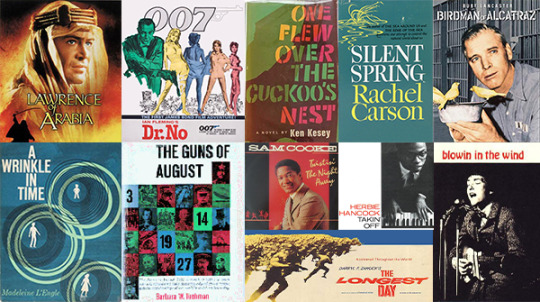
Every year, Jennifer Jenkins and Jamie Boyle from the Duke Center for the Public Domain compile a "Public Domain Day" list (previously) that highlights the works that are not entering the public domain in America, thanks to the 1998 Sonny Bono Copyright Term Extension Act, which hit the pause button on Americans' ability to freely use their artistic treasures for two decades -- a list that also included the notable works entering the public domain in more sensible countries of the Anglophere, like Canada and the UK, where copyright "only" lasted for 50 years after the author's death.
But this year, it's different.
This is the year that America unpauses its public domain; it's also the year that Canadian PM Justin Trudeau capitulated to Donald Trump and retroactively extended copyright on works in Canada for an extra 20 years, ripping works out of Canada's public domain, making new works based on them into illegal art (more proof that good hair and good pecs don't qualify you to be a good leader -- see also: V. Putin -- not even when paired with high-flying, cheap rhetoric).
Even as Canada's public domain has radically contracted, America's has, for the first, time, opened.
So this year's American Public Domain Day List is, for the first time in 20 years, not a work melancholy alternate history, but rather a celebration of works that Americans are newly given access to without restriction or payment, for free re-use and adaptation, in the spirit of such classics as Snow White, West Side Story, My Fair Lady, All You Need is Love, and more.
Films
* Safety Last!, directed by Fred C. Newmeyer and Sam Taylor, featuring Harold Lloyd
* The Ten Commandments, directed by Cecil B. DeMille
* The Pilgrim, directed by Charlie Chaplin
* Our Hospitality, directed by Buster Keaton and John G. Blystone
* The Covered Wagon, directed by James Cruze
* Scaramouche, directed by Rex Ingram
Books
* Edgar Rice Burroughs, Tarzan and the Golden Lion
* Agatha Christie, The Murder on the Links
* Winston S. Churchill, The World Crisis
* e.e. cummings, Tulips and Chimneys
* Robert Frost, New Hampshire
* Kahlil Gibran, The Prophet
* Aldous Huxley, Antic Hay
* D.H. Lawrence, Kangaroo
* Bertrand and Dora Russell, The Prospects of Industrial Civilization
* Carl Sandberg, Rootabaga Pigeons
* Edith Wharton, A Son at the Front
* P.G. Wodehouse, works including The Inimitable Jeeves and Leave it to Psmith
* Viginia Woolf, Jacob's Room
Music
* Yes! We Have No Bananas, w.&m. Frank Silver & Irving Cohn
* Charleston, w.&m. Cecil Mack & James P. Johnson
* London Calling! (musical), by Noel Coward
* Who’s Sorry Now, w. Bert Kalmar & Harry Ruby, m. Ted Snyder
* Songs by “Jelly Roll” Morton including Grandpa’s Spells, The Pearls, and Wolverine Blues (w. Benjamin F. Spikes & John C. Spikes; m. Ferd “Jelly Roll” Morton)
* Works by Bela Bartok including the Violin Sonata No. 1 and the Violin Sonata No. 2
* Tin Roof Blues, m. Leon Roppolo, Paul Mares, George Brunies, Mel Stitzel, & Benny Pollack (There were also compositions from 1923 by other well-known artists including Louis Armstrong, Irving Berlin, George Gershwin, WC Handy, Oscar Hammerstein, Gustav Holst, Al Jolson, Jerome Kern, and John Phillip Sousa; though their most famous works were from other years.)
And as great as that list is, it's hardly a patch on the amazing works we'd be inheriting if the Sonny Bono law hadn't been passed and the 1978 law was still on the books -- works whose authors fully expected them to be in the public domain as of tomorrow:
Books
* Madeleine L’Engle, A Wrinkle in Time
* Rachel Carson, Silent Spring
* Barbara Tuchman, The Guns of August
* Katherine Anne Porter, Ship of Fools
* James Baldwin, Another Country
* Philip K. Dick, The Man in the High Castle
* Thomas Kuhn, The Structure of Scientific Revolutions
* Vladimir Nabokov, Pale Fire
* Anthony Burgess, A Clockwork Orange
* Michael Harrington, The Other America
* Milton Friedman, Capitalism and Freedom
* J.G. Ballard, The Drowned World
* Ray Bradbury, Something Wicked This Way Comes
* Ken Kesey, One Flew Over the Cuckoo’s Nest
* Edward Albee, Who’s Afraid of Virginia Woolf?
* Aleksandr Solzhenitsyn, One Day in the Life of Ivan Denisovich
* Doris Lessing, The Golden Notebook
* Helen Gurley Brown, Sex and the Single Girl
* Ingri d’Aulaire and Edgar Parin d’Aulaire, D’Aulaires’ Book of Greek Myths
Movies
* Lawrence of Arabia
* The Longest Day
* The Manchurian Candidate
* Dr. No
* Jules and Jim
* Sanjuro
* Birdman of Alcatraz
* Mutiny on the Bounty
* Days of Wine and Roses
* How the West Was Won
Music
* Dream Baby (How Long Must I Dream), by Cindy Walker, performed by Roy Orbison
* Blowin’ in the Wind, Bob Dylan
* Watermelon Man, Herbie Hancock (from his first album, Takin’ Off)
* Twistin’ the Night Away, Sam Cooke
* You Can’t Judge a Book by the Cover and You Shook Me, Willie Dixon
* Surfin’ Safari, The Beach Boys
* Songs from A Funny Thing Happened on the Way to the Forum, Stephen Sondheim
* Dream Baby (How Long Must I Dream), Cindy Walker
* Big Girls Don’t Cry, Bob Crewe and Bob Gaudio
* Breaking Up Is Hard To Do, Neil Sedaka and Howard Greenfield
* Little Boxes, Malvina Reynolds
* The Loco-Motion, Gerry Goffin and Carole King
* Soldier Boy, Luther Dixon and Florence Greenberg
And, as Jenkins and Boyle point out, the largely hidden casualty of copyright term extension is the scholarship and research published in academic journals, who paid nothing for these works, and who have locked them up for decades to come:
https://boingboing.net/2018/12/31/thanks-justin.html
337 notes
·
View notes